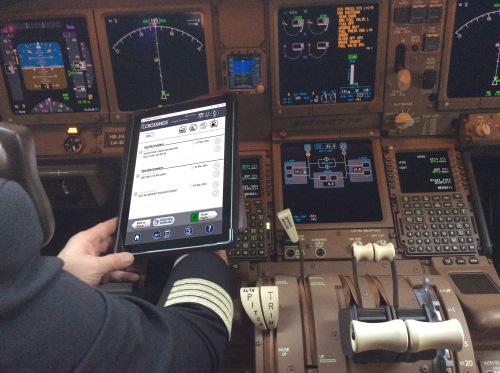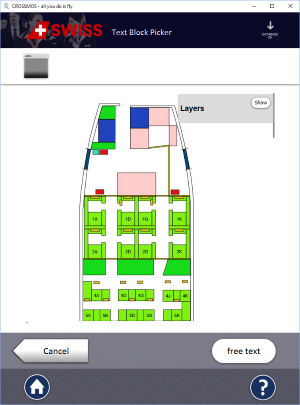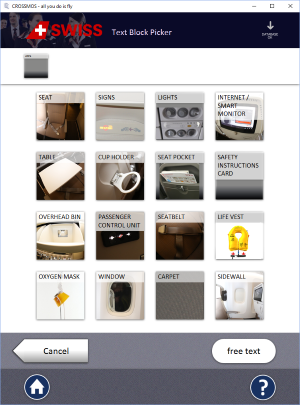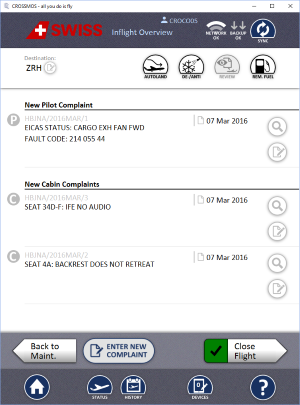Articles
| Name | Author | |
|---|---|---|
| Column: The World according to IT and me.. Absolutely Phabulous | Paul Saunders, Solution Manager, Flatirons Solutions | View article |
| Data connectivity for EFBs Part 2 | Bill Vlases, Manager EFB Solutions, Boeing | View article |
| Case Study: Electronic Technical Logbook at Swiss International Airlines | Marcus Di Laurenzio, Technical Project Engineer, SWISS International Airlines, and Udo Stapf, CEO, CrossConsense | View article |
| Aircraft Tracking | Henk Hof, Chairman of ICAO ad-hoc Working Group, Eurocontrol | View article |
Case Study: Electronic Technical Logbook at Swiss International Airlines
Author: Marcus Di Laurenzio, Technical Project Engineer, SWISS International Airlines, and Udo Stapf, CEO, CrossConsense
SubscribeElectronic Technical Logbook at Swiss International Airlines

Working together from the start can, Marcus Di Laurenzio, Technical Project Engineer, SWISS International Airlines and Udo Stapf, CEO, CrossConsense find, ensure a better and more effective project

This case study will focus on why and how Swiss International Air Lines (SWISS) selected and implemented the CROSSMOS Electronic Tech Log / Electronic Log Book from CrossConsense, and what were their objectives in doing so. We’ll also look at the challenges encountered during the project and what benefits have flowed from having a paperless flight deck. But first a brief look at the two main protagonists.
SWISS INTERNATIONAL AIR LINES (SWISS)
SWISS operates 93 aircraft; 29 long-haul (Airbus 330 and 340 types) and 53 short haul models (Airbus 320 types and Avro RJ100). From the beginning of 2016, the A340s will be replaced with nine Boeing 777 aircraft while from mid-2016, the RJ100 fleet will be replaced with Bombardier CSeries-100 and -300. The airline has two main bases in Zurich and Geneva and, in 2014-5 SWISS flew 16 million passengers to and from 102 destinations in 46 countries.
CROSSCONSENSE
The business started in 2002 providing solutions around AMOS (from Swiss-AS). Over the years, CrossConsense has built a product portfolio with hosting services, consulting, BI reporting, Smart Apps… around AMOS and with interfaces to other systems and back-end systems. The company started thinking about a TechLog three or four years ago.
WHAT SWISS NEEDED
When SWISS started to look for an electronic log book (ELB) there were a number of requirements that they wanted to meet. The new solution would have to be flexible to work across the fleet on commercial off-the-shelf (COTS) hardware but on different devices to enable the airline to use hardware already in place for its EFB (electronic flight bag) and so that they could replace the hardware if need be. There was also the cost factor. SWISS needed a master device in the cockpit with a separate device for the cabin to let them work independently with synchronization achieved using connectivity. One key point was off-line capability so that the system could be run without having a constant connection with a ground server because SWISS currently has no connectivity in flight. Pilots and cabin crew were to be able to report any issue to the system in real time and then, on landing, connectivity would be restored and the on-board system could synchronize the ELB with the MRO system. In the event of no connectivity on the ground, SWISS did not want there to be a delay. The airline considered four different ELBs but found none to match their requirements; so they sought out a developer who could create an ELB that would match the airline’s needs and with whom SWISS could have some input to the development process.
HOW CROSSCONSENSE BECAME INVOLVED
In a separate move from this SWISS project but after attending a Flight Ops Conference in London, CrossConsense started to think about what kind of software, Apps and ideas might they be able to develop based on their experience with AMOS and in the aviation industry. The decision to develop an ELB derived from a wish to create their own product for the market, to leverage the considerable experience gained from 42 AMOS installations into developing a really strong product that was both flexible to accommodate different customer requirements and adaptations but was also a standardized solution in line with the many standards and regulations applying in the aviation sector.
The focus was always on the practical relevance of the product and CrossConsense learned from their partners at Swiss Aviation Software whose AMOS product is very practice oriented which was what CrossConsense wanted from their new ELB development. The product was not so much driven by ideas as by a workshop to find a common audience for the development. The workshop was held in Frankfurt and CrossConsense’s existing customers were invited to see the developer’s vision, their thoughts about getting a ‘best of breed’ product, connectivity and open interfaces. The response from the customers at the workshop was that all of that was really nice but to keep it simple and keep it flexible.
In all of this, CrossConsense had not been aware of Swiss International’s interest in acquiring an ELB solution but the workshop brought the two ideas together which helped both parties in starting a development with SWISS as launch customer but with a further 13 airlines who had been at the workshop and who joined CrossConsense in monthly telephone conferences and web conferences to discuss further development in the following months. The idea was to develop a product that would work for those 13 airlines of all sizes and which would then be likely to be suitable for many other airlines.




SPECIFICATION FOR SWISS INTERNATIONAL
As long as thirteen years ago, Swissair (SWISS’s predecessor operator) had launched an electronic Cabin log and ten years of using that meant that SWISS already had a lot of experience in the field by the time the current project was being discussed. However, with a new MRO system and new IT technology in the airline, the old system was no longer state-of-the-art or compatible. Senior management at the airline wanted to make a business case for a new ELB. The requirement, as we’ve already seen above, was for a single paperless solution to serve both the cockpit and the cabin (TechLog, maintenance log, flight log, cabin log) across the whole fleet and for long or short haul flights. It would also need to save time and money. Furthermore, SWISS wanted to achieve an improvement in quality with any new solution, in particular they wanted a commonality of language to ensure that pilots, cabin crew and maintenance all used the same terms to describe an issue. It was a demanding brief and difficult to meet and so SWISS were pleased to be able to work with CrossConsense. SWISS’s management saw the specification as a good concept with which to start the project which had also to fit in with the airline’s overall plan to go paperless across the business; from the cockpit, throughout Operations and in the maintenance area.
Under this global specification were a number of specific objectives. SWISS wanted to reduce manual data inputs by achieving ‘single data entry’ for the new solution. The old paper processes entailed filling forms and passing those on to the relevant department where the information would be entered to the system. In 2012 that included 70,000 log slips. Unfortunately, poor handwriting or forms being completed in awkward places often made it difficult to fully understand what the problem being report was which meant further checking with the source… all this cost time and money. With an electronic log book, there is a database with clear text, all warnings for pilots, fuel information as well as all information needed in the cabin. This all makes the process easy and reduces the time and cost of entailed. It also reduces the space required for archiving while improving data quality and preventing anything entering the system with missing information.
The target was that, if a mechanic worked on an aircraft there would be no need for them to refer to the back office or any part of the ground system in order to understand the job in hand. It would also mean that, when the job is finished, everything required for the process would be complete as part of the sign-off.
CROSSCONSENSE: HELPING AIRLINES TO SAVE MONEY
Once discussion for CrossConsense with SWISS got underway, the solutions developer took the airline’s requirements to consider how those needs could be matched and how that compared with CrossConsense’s own visions. One conclusion was that whatever emerged from the development should be a solution that, whoever was using it, pilot, cabin crew or a technician, should find themselves in an environment tailored to their job and that the solution should be self-explanatory, lean and practice oriented – a requirement and a challenge. It was also important that the new solution be able to run on different hardware devices.
At first CrossConsense developed their log book on a Panasonic Toughpad because it was robust, could be operated in any light conditions and any weather conditions. For some airlines the Toughpad was a bit expensive and so there was always the need to have a solution that would be hardware independent. The solution currently will run on any device as long as it’s a Windows-based system: The choice for Windows as the first platform supported was based on the fact that Windows systems offer many connectivity and hardware options, making it easy to integrate with existing soft- and hardware as well as processes. Ensuring data integrity under all circumstances was a main driver for this decision. CrossConsense is currently developing an iOS version.
The solution that CrossConsense developed, CROSSMOS, offers a pilot mode, a cabin mode and a maintenance mode; and it has connectivity within the aircraft where one device in the cabin can talk to the pilot’s device.
The really important message for CrossConsense and other developers in this market is that software is developed with a group of customers; there has to be a practical use case that is practice oriented and widely accepted, only then it will be fit for the whole market.

CHALLENGES
This project faced a number of challenges that the two main partners had to address. First of all, this was to develop and implement a new idea for a full and complex system that had to be sold to airline management who, at the outset were more sensitive to the risks than aware of the benefits. And, of course, any scheme has to get approval from all relevant authorities which, as readers might be aware, is a challenge in itself when there is one project and multiple authorities to satisfy.
Also, there is a need to have a change management plan. New software doesn’t always run fully as intended from the outset which makes it a challenge to win over the people who will have to use it. In this case, the pilots would need to use the new system at the times when they were under maximum pressure, before and immediately after each flight. And people used to simply making a written entry and then closing the book need to be comfortable with the different procedures and steps with an electronic alternative.
There is also an issue around connectivity with SWISS’s legacy Airbus fleet not having any connectivity; there was no server on board such as there is with newer aircraft and so a solution had to be found to create Wi-Fi connectivity between the master device and the cabin device within the aircraft and from the master device out to the ground system using GSM. SWISS undertook research with aircraft in various environments and locations to see how well data could be transferred to ground systems. This was important because, without connectivity, an electronic log book would not be of much use.
There had to be processes and infrastructure installed so that all devices could be charged and, of course, the system had to be secure which meant implementing a log-in process with usernames and passwords.
It was also a challenge for CrossConsense to both ‘keep it simple’ with no extraneous features but ensure that everything that is needed is available and accessible. In a similar sense, SWISS required that the new software be self-explanatory, not needing to be trained. So, a user should be able to see exactly what to do without needing assistance. Finally, CrossConsense wanted to develop a standard solution but with the flexibility to embrace each individual airline’s needs.
ORGANIZING THE PROJECT
Fig 1 shows how the project was organized with a Project Lead at the top of the table which is set out at two levels. The group of functions immediately below the Project Lead had, among other things, to steer the project and ensure close co-operation with the authorities. As we’ve already mentioned, getting the authorities onboard is very important when there are so many new processes and technologies involved and, of course, they finally need to approve the new manuals for the system before it can go live. Also at this level, SWISS benefited from inputs from both the solution provider, CrossConsense, and the aircraft OEM, Boeing.

At the second level, SWISS was careful to involve representatives of the key user groups, people who’d be most affected by the change so that their thoughts and inputs could be taken into account and/or addressed at every stage. This included representatives of the pilots, cabin crew, maintenance engineers and technicians who’d have to work with the new system. There were also representatives from IT to handle issues such as connectivity, security and VPN (virtual private network) links from the master device to the host server. And it was important to involve the ELB administrator who would have to manage the whole thing when it was up and running and who could contribute some of the ‘local’ work.
At both levels, it was very important that SWISS involved key players right from the outset for the good of the project and to ensure that the change management program would be well supported.
GETTING APPROVAL
This is, as every reader will know, a pivotal matter for any project and so SWISS and CrossConsense defined a strategy starting at the concept stage when all of the relevant people from the authorities were involved. There was a presentation about the planned project, where it intended to go and what the future would hold, so that, not only were the authorities in the loop but also they had an opportunity to ask questions about areas of their concern (such as back-ups and fail-safe procedures) at the earliest stage which gave SWISS and CrossConsense the opportunity to build requirements in from the outset – a great time and resource saver. What this also did was build trust into the process from the start. At the end of the project, before go-live, the authorities were again invited to learn all about the new system as it had been developed and how it worked in practice; and they had the chance to use a tablet and ‘try’ the system themselves. This all made it easy for the authorities to approve the aircraft logbook procedure manual which was needed for go-live in early 2016.
GO-LIVE FOR THE NEW SYSTEM
SWISS decided to introduce the new system and a new aircraft when the first Boeing 777 was delivered to the airline at the end of January 2016. The operator saw this as a good opportunity to equip the new aircraft with the new electronic log book in the first four weeks of flight training and pilot training to ensure that, through ‘real’ experience, they could be sure that everything worked in practice.
The next step was training starting with the maintenance engineers in classroom training because they have to deal with the most functionality on the software. A handbook was prepared and a movie was created to show the process and how the log book is used. For cabin crew it only needed a bulletin to cover the few ‘click’ functions that concerned them. The cockpit crew were given the information via the Aircraft Logbook Procedure Manual (ALPM), a training module and the Handbook.
As the go-live approached, CrossConsense, in preparing the Release Candidate, increased the frequency of its Sprints (to complete each block of the project) from monthly to biweekly and held regular conference calls with SWISS to iron out any issues that needed closer examination. Also, the project managers on the SWISS side and developers in CrossConsense cooperated closely.
Finally, before the go-live, there were two more things; approval of all the processes, which had been subject to significant changes to accommodate the new system, plus approval of documents and manuals for the new system.
ROLL-OUT OF THE NEW SYSTEM
As already mentioned, SWISS started the roll-out with the Boeing 777 at delivery and, as soon as Operations is satisfied, there will be a further roll-out to the rest of the long-haul fleet; the A330 and A340 aircraft, over a three day period as the aircraft are turned around. With the A320 short-haul fleet it will be a bit more difficult and take a little more time as the aircraft are busier; and the same will be true for the Avro fleet. When the Bombardier CS100 aircraft start to be delivered in mid-2016, they will be fitted with the new system as an integrated solution from the start.
The hardware consists of two Microsoft Surface Tablets with the CROSSMOS ELB installed, one in the cockpit, one in the cabin, plus a Mini-Router in every aircraft.
Server penetration tests have already been completed to confirm their security and during the Roll-Out (and afterwards), CrossConsense is available to deal with any bugs that might arise in use. The next plan is to link manuals to CROSSMOS along with a Dent & Buckle chart for the aircraft in question. There will also be continuous improvement of CROSSMOS and integrations of other CrossConsense capabilities (a reliability tool to support predictive maintenance, machine learning tools to further standardize text and RFID components for cabin safety checks) with SWISS having the opportunity to customize the system using the integrated admin tool.
The plan is that the new system should sit at the heart of a well-run airline.
Contributor’s Details
 Marcus Di Laurenzio
Marcus Di Laurenzio
Project Manager
SWISS International Air Lines
Marcus Di Laurenzio is the project manager of the SWISS Electronic Log Book project and coordinates all the stakeholders from operational- and technical business units.
Marcus started his career as an aircraft Engineer 1988 with SWISSAIR technical department. After having completed his degree as an electronic specialist he worked in several engineering departments and operations (Dragon Air and Gulf Air).
For the last 2 years, Marcus has been working for the projects implementation of an electronic log book of all aircraft types flying in Swiss fleet, setup infrastructure for enabling functions of the Boeing B777 model and as well for the Bombardier CS100/300 models.
 Udo Stapf
Udo StapfChief Executive Officer
CrossConsense
Udo Stapf is the founder and CEO of CrossConsense, an eLB, server hosting, software support- and solutions provider based in Frankfurt, Germany. Since 1990 he has been working in the aviation industry, starting as an aircraft line and base maintenance engineer and AMOS integration specialist. After he completed his degree as a business economist he worked as a logistics manager for a German charter airline until he founded CrossConsense 2002.
For the last 13 years, CrossConsense has become a known name in the aviation industry especially in the fields of AMOS consulting, support, hosting and operation. In 2012 CrossConsense started to develop – in collaboration with 13 of its airline customers –CROSSMOS, an electronic technical logbook.
 Swiss International Air Lines (SWISS) is the national airline of Switzerland. From Zurich and Geneva the SWISS fleet serves a total of 102 destinations worldwide in 46 countries. With a fleet of 93 aircraft SWISS transported over 16 million passengers annually. The cargo division SWISS WorldCargo offers a comprehensive airport-to-airport service for high-quality goods and care-intensive freight to 130 destinations in over 80 countries. As Switzerland’s national airline, SWISS stands for traditional values and is committed to the highest product- and service quality.
Swiss International Air Lines (SWISS) is the national airline of Switzerland. From Zurich and Geneva the SWISS fleet serves a total of 102 destinations worldwide in 46 countries. With a fleet of 93 aircraft SWISS transported over 16 million passengers annually. The cargo division SWISS WorldCargo offers a comprehensive airport-to-airport service for high-quality goods and care-intensive freight to 130 destinations in over 80 countries. As Switzerland’s national airline, SWISS stands for traditional values and is committed to the highest product- and service quality.

CrossConsense was founded 2002. It is run by 30+ well trained, highly skilled, experienced and extraordinary motivated team workers. CrossConsense aims to offer its business partners from the aviation industry the best services they can get on the basis of a sound knowledge in the areas of maintenance, engineering and logistics. CrossConsense’s employees think IT from a user perspective – they are not just IT freaks! Contact: marketing@crossconsense.de, www.CrossConsense.com
Comments (0)
There are currently no comments about this article.

To post a comment, please login or subscribe.